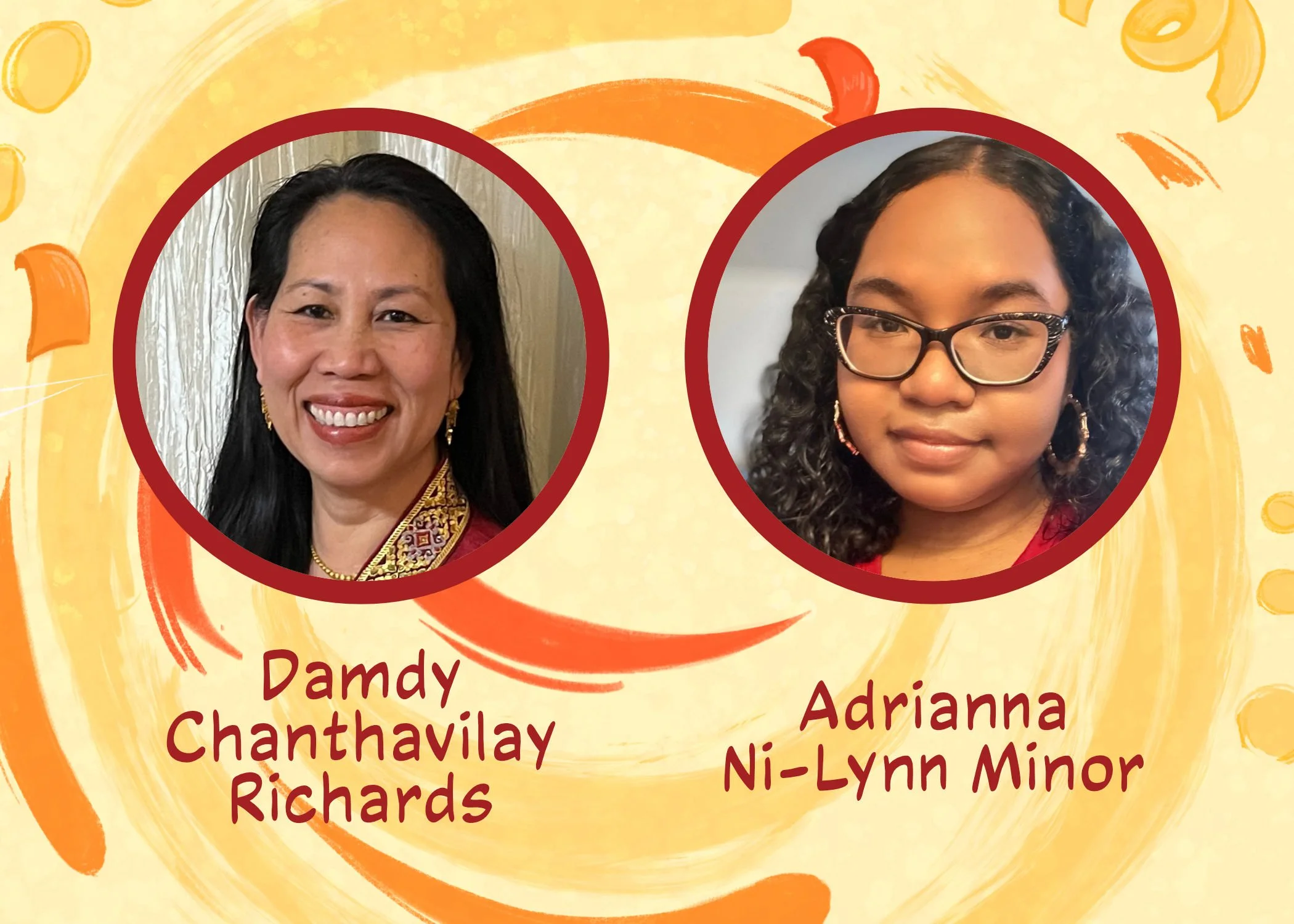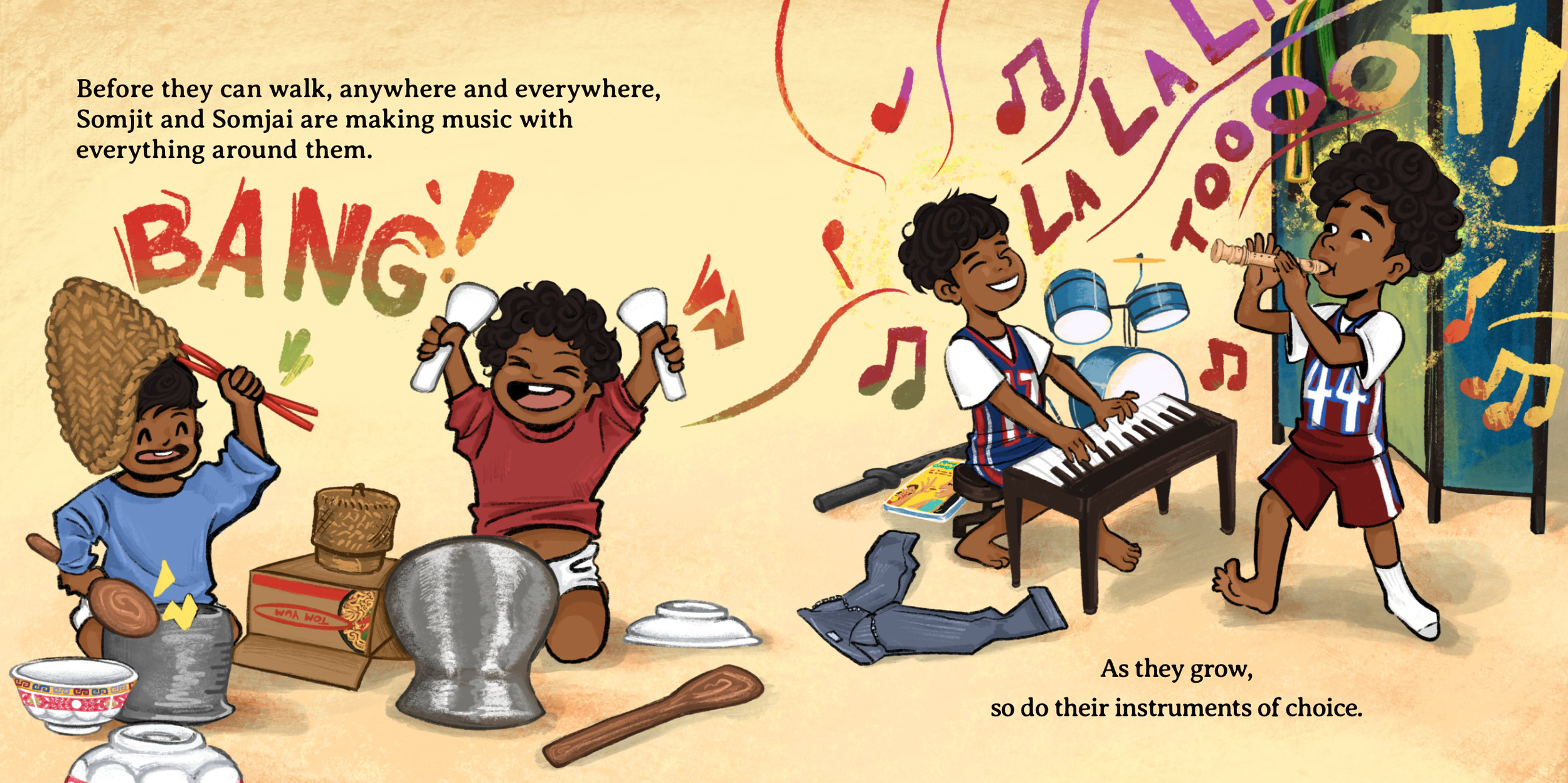In the landscape of children’s literature, where representation matters more than ever, comes a unique collaboration between aunt and niece that bridges generations of Lao American experience. “Somjit & Somjai’s Musical Journey” is more than just a children’s book—it’s a cultural preservation project born from a remarkable story: Dr. Damdy Chanthavilay Richards, who arrived in America as a refugee and became a successful dentist, has partnered with her niece, emerging artist Adrianna Ni-Lynn Minor, to create a vibrant celebration of Lao musical heritage.
“Music has always been a significant part of all of our celebrations and ceremonies. Even today, I can still faintly hear some of the instruments as they were playing.” – Dr. Damdy Chanthavilay Richards

Origins & Inspirations
What inspired you to create/illustrate a children’s book about Lao musical instruments?
Damdy: My two sons inspire me to write a children’s book about Lao musical instruments. They have enjoyed learning and playing the Lao instruments since they were young and I want to share their love and experience with others.
Adrianna: I was deeply inspired by the prospect of promoting Lao culture through “Somjit & Somjai’s Musical Journey”. As someone who grew up with limited access to Lao representation in the media, I was ecstatic to join in on this project to spread knowledge about our culture. I passionately illustrated this book so that Lao kids can relate to, learn from and proudly share their cultural identity.
Can you tell us about your personal connection to Lao culture and how it influences your work?
Damdy: I was born in Laos and as a young girl, I always enjoy listening and watching Lao traditional music and dance. As I write this book, it draws me closer to my childhood memory.
Adrianna: As someone who is half Lao, I have always cherished my Lao heritage. I have a very close-knit Lao family, and I learned valuable cultural lessons from them. This personal connection influenced me to pour my heart into illustrating “Somjit & Somjai’s Musical Journey”, creating a sense of warmth and belonging within its pages.

Creative Journey
What was the most challenging aspect of writing/illustrating “Somjit & Somjai’s Musical Journey”?
Damdy: The most challenging aspect of writing “Somjit & Somjai’s Musical Journey” is expressing my thoughts and feelings so they can be experienced and understood by the readers.
Adrianna: A huge challenge I faced was consistently drawing the same characters throughout the book without making them appear different on each page. Specifically, maintaining the distinct characteristics of each character to ensure easy recognition. For example, capturing Aaron and Adam’s curl patterns on each page was challenging. As an illustrator that likes details, this was difficult to achieve.
How do you hope this book will impact young Lao American readers?
Damdy: I hope that this book will deepen the curiosity and inspire Lao American readers so they can look further to uncover more about their culture.
Adrianna: I hope “Somjit & Somjai’s Musical Journey” will bring greater representation to young Lao readers. I imagine them excitedly pointing at one of the instruments in the book, saying, “Hey, I have that instrument!” I also hope that this book will bring Lao culture to all children’s shelves; to have them find joy in reading this colorful story and the Lao culture within.
Damdy, as a dentist by profession, how did you balance your career with writing this book?
Damdy: It’s important for me to set aside time on a consistent basis in order to fulfill my goal to finish this book.
Adrianna, can you walk us through your process of bringing the Lao instruments to life through your illustrations?
Adrianna: When illustrating instruments, I start with a basic, geometric base and focus on the main colors. For example, the Kim illustration started with a soft regular base and was colored with warm brown and tan tones. After that, I added darker colors to create shadows and define any instrument design elements. Lastly, I apply lighter colors to enhance form and create a “pop” effect. To get the depth and dimension I want, I gradually build it up with the base, dark, and light colors. Throughout this process, I keep in mind my priority to make the instruments prominently visible, as traditional music and instruments are part of the main focus in the book.
Cultural Heritage & Impact
What’s your favorite Lao musical instrument, and why?
Damdy: One of my most vivid memory as a girl growing up in Laos was listening to the harmonic melody of the Kaen.
Adrianna: My favorite instrument is the Sor. The reason is because it was the very first Lao instrument I touched. I learned how to play it during my days at LHF’s Lao Summer Camp as a young girl. My peers and I attempted to learn and play “Twinkle Twinkle Little Star” on it. My skills were awful but the memory was great! I love the Sor and applaud anyone who knows how to play it right.
How did your collaboration with Sahtu Press and the Lao Heritage Foundation come about?
Damdy: I want to create a vehicle to express to those who are less familiar with Lao culture.
Adrianna: My involvement with Lao Heritage Foundation started when I attended their Lao Summer Camp in Virginia, around the ages 10-12 years old. Although I eventually stopped attending camp, I still remained connected by attending their annual performances and participating in events. The collaboration with Sahtu Press happened when my aunt, Damdy Chanthavilay Richards, author of ‘Somjit & Somjai’s Musical Journey,’ offered me an opportunity to further develop my illustration skills and explore illustration work with Nor Sanavongsay of Sahtu Press. This partnership has significantly helped me grow as an artist!
Were there any surprising discoveries you made about Lao culture or music while working on this project?
Damdy: I discovered that Lao traditional music can be categorized as folk and classical music.
Adrianna: I’m not well-versed in Lao music. I’m only familiar with instrument names and sounds. However, working on “Somjit & Somjai’s Musical Journey” led to a surprising discovery — the traditional Lao song “Champa Muang Lao.” I thought I didn’t know this song, but once I listened to it, I immediately recognized the melody. I realized I had forgotten the name; it was a song buried deep within my memories. So, it was fun to research and illustrate the notes while having nostalgia.
Looking Forward
What message do you hope parents and children take away from this book?
Damdy: The message I hope parents and children take away from this book is the understanding of our unique culture and the sense of belonging.
Adrianna: I hope that this book can send the message for children to not be afraid of exploring their culture and to appreciate and take pride in it. Same goes for everyone who thinks it’s “too late” to get into their ethnic culture. It’s never too late! Be curious and learn about your heritage, whenever you want!
Can you share a memorable moment from your childhood that relates to Lao music or culture?
Damdy: Music has always been a significant part of all of our celebrations and ceremonies as I was growing up in Laos. Even today, I can still faintly hear some of the instruments as they were playing.
Adrianna: Every Lao New Year, I would attend the Nang Sangkhan ceremony. I participated in this ceremony as part of the Sangkhan ladies for about 8 years. I cherish memories of dressing up in traditional Lao attire with family and friends at our local temple, as well as preparing together. My all-time favorite part was the water fight at the end. Siblings, friends, cousins, aunties and even monks participated in this activity! We used blessing water and any other water we could find — including the hose! It was incredibly fun!
What advice would you give to aspiring Lao American writers or artists who want to share their culture through their work?
Damdy: My advice to aspiring Lao American writers and artists who want to share their culture through their work is, to not let anything prevent them from expressing themselves.
Adrianna: Go for it! Our community deserves all the representation it can get, and sharing culture will spread love for Lao heritage. Additionally, make sure you have enough time to curate your works. Balancing personal life and illustrations can be hard but with enough motivation and perseverance, it’s achievable!

A Note About Lao Musical Instruments
The book features several traditional Lao instruments, including:
-
The Kaen: A mouth organ made of bamboo pipes
-
The Sor: A traditional two-string fiddle
-
The Kim: A hammered dulcimer
About the Characters
Somjit and Somjai, the book’s protagonists, are inspired by the author’s sons, Adam Somjit and Aaron Somjai. Their journey through Lao musical traditions reflects real experiences of young Lao Americans discovering their heritage.
This groundbreaking collaboration between Dr. Richards and Minor represents more than just a family project—it’s a bridge between generations of Lao Americans, connecting those who carried their traditions across oceans with those who are rediscovering them today. Through the universal language of music and the power of visual storytelling, “Somjit & Somjai’s Musical Journey” promises to be a vital addition to the growing body of Lao American children’s literature published by Sahtu Press in partnership with the Lao Heritage Foundation.
